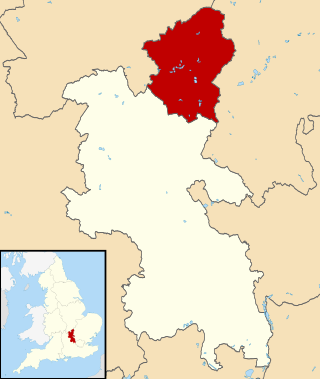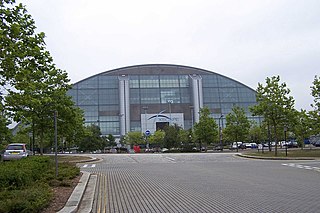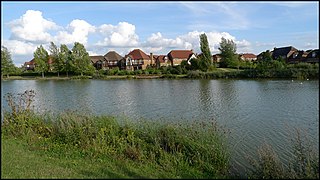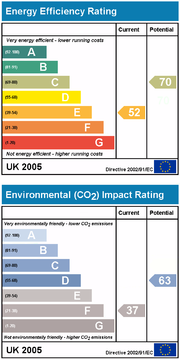
The City of Milton Keynes is a unitary authority area with both borough and city status, in Buckinghamshire. It is the northernmost district of the South East England Region. The borough abuts Bedfordshire, Northamptonshire and the remainder of Buckinghamshire.

Bletchley is a constituent town of Milton Keynes, Buckinghamshire, England. It is situated in the south-west of the city, and is split between the civil parishes of Bletchley and Fenny Stratford and West Bletchley.
Shenley is an area of Buckinghamshire consisting of the villages and areas Shenley Brook End, Shenley Church End, Shenley Dens, Shenley Grounds, Shenley Lodge and Shenley Wood. It is one of the parts of the region that went to make up the new city of Milton Keynes in the 1960s. Shenley is located to the west of the city centre, on the Roman road Watling Street between Stony Stratford and Fenny Stratford.
Shenley Brook End is a village, district and wider civil parish in Milton Keynes, Buckinghamshire, England, located about 2 miles (3.2 km) north-west of Bletchley, and 2.5 miles (4.0 km) south-west of Central Milton Keynes. Together with its neighbouring districts of Shenley Church End, Shenley Wood and Shenley Lodge, the districts are collectively known as "The Shenleys".

Shenley Church End is a village, district and wider civil parish in Milton Keynes, Buckinghamshire, England, about 2 miles (3.2 km) south-west of Central Milton Keynes, and the same distance north-west of Bletchley. Together with its neighbouring districts of Shenley Brook End, Shenley Wood and Shenley Lodge, the districts are collectively known as "The Shenleys".
Westcroft is a district in the western part of Milton Keynes, Buckinghamshire, England, in the civil parish of Shenley Brook End.

A low-energy house is characterized by an energy-efficient design and technical features which enable it to provide high living standards and comfort with low energy consumption and carbon emissions. Traditional heating and active cooling systems are absent, or their use is secondary. Low-energy buildings may be viewed as examples of sustainable architecture. Low-energy houses often have active and passive solar building design and components, which reduce the house's energy consumption and minimally impact the resident's lifestyle. Throughout the world, companies and non-profit organizations provide guidelines and issue certifications to guarantee the energy performance of buildings and their processes and materials. Certifications include passive house, BBC—Bâtiment Basse Consommation—Effinergie (France), zero-carbon house (UK), and Minergie (Switzerland).

Central Milton Keynes is the central business district of Milton Keynes, Buckinghamshire, England and a civil parish in its own right, with a town council.

Shenley is a village and civil parish in Hertfordshire, England, between Barnet and St Albans. The village is located 14 miles from Central London. As of 2021, the population of the parish was 5,390; however, the parish stretches far beyond the village itself; it is the largest parish in Hertsmere and is very rural, including hamlets and farming settlements such as Dancers Hill, Green Street, Kitts End, Ridge, Saffron Green, Shenleybury, and the largest other settlement, South Mimms.
Milton Keynes Development Corporation (MKDC) was a development corporation operating from 1967 to 1992 oversee the planning and early development of Milton Keynes, then a planned new town midway between London and Birmingham.
Domestic housing in the United Kingdom presents a possible opportunity for achieving the 20% overall cut in UK greenhouse gas emissions targeted by the Government for 2010. However, the process of achieving that drop is proving problematic given the very wide range of age and condition of the UK housing stock.
EcoHomes was an environmental rating scheme for homes in the United Kingdom. It was the domestic version of the Building Research Establishment's Environmental Assessment Method BREEAM, which could also be applied to a variety of non-residential buildings. It was replaced by the Code for Sustainable Homes in April 2008.

This history of Milton Keynes details its development from the earliest human settlements, through the plans for a 'new city' for 250,000 people in northern Southeast England, its subsequent urban design and development, to the present day. Milton Keynes, founded in 1967, is the largest settlement and only city in Buckinghamshire. At the 2021 census, the population of its urban area was estimated to have exceeded 256,000.
The Code for Sustainable Homes was an environmental assessment method for rating and certifying the performance of new homes in United Kingdom. First introduced in 2006, it is a national standard for use in the design and construction of new homes with a view to encouraging continuous improvement in sustainable home building. In 2015 the Government in England withdrew it, consolidating some standards into Building Regulations.

Furzton is a district in south-west Milton Keynes, Buckinghamshire, England and in the civil parish of Shenley Brook End The man-made Furzton Lake is a balancing lake that covers approximately half of the district. The district lies just north of Bletchley, and roughly 2 miles (3.2 km) south of Central Milton Keynes.

The Pennyland project was one of a series of low-energy building experiments sparked by the 1973 oil crisis. It involved the construction of an estate of 177 houses in the Pennyland area of Milton Keynes, Buckinghamshire, United Kingdom. It compared possible future UK building efficiency standards with newly introduced Danish ones.
The Standard Assessment Procedure (SAP) is the UK government's recommended method system for measuring the energy rating of residential dwellings. The methodology is owned by the Department for Business, Energy & Industrial Strategy, and produced under licence by BRE. The first version was published in 1995, and was replaced by newer versions in 1998, 2001, 2005, 2009, 2012, and 2021. It calculates the typical annual energy costs for space and water heating, and, from 2005, lighting. The CO2 emissions are also calculated. The SAP runs from 1 to 100+, with dwellings that have SAP>100 being net exporters of energy.

Energy performance certificates (EPCs) are a rating scheme to summarise the energy efficiency of buildings. The building is given a rating between A - G (Inefficient). The EPC will also include tips about the most cost-effective ways to improve the home energy rating. Energy performance certificates are used in many countries.

The National Energy Foundation (NEF) is an independent British charity, established to improve the use of energy in buildings.

Loughton and Great Holm is a civil parish in the City of Milton Keynes, Buckinghamshire, England. It includes the districts of Loughton, Great Holm, the National Bowl and Elfield Park, West Rooksley, Loughton Lodge, and Knowlhill. It is bordered by H4 Dansteed Way to the north, V4 Watling Street to the west, a tiny stretch of H8 Standing Way to the south, and the West Coast Main Line to the east. Originally named Loughton, it was renamed to Loughton and Great Holm in 2013














